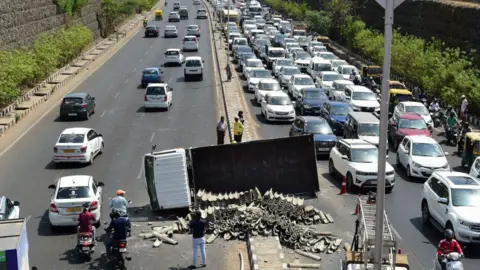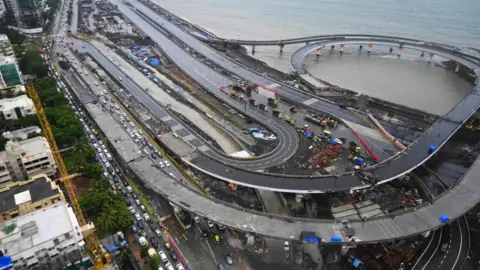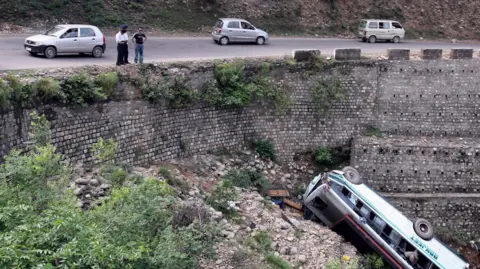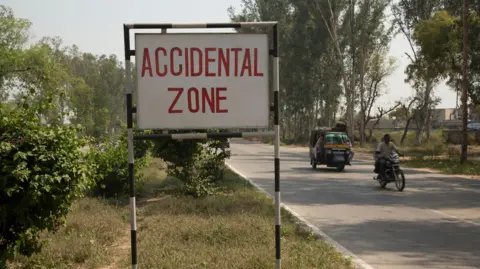A death every three minutes: Why India's roads are among the world's deadliest
 Getty Images
Getty ImagesEvery morning, India's newspapers are filled with reports of road accidents - passenger buses plunging into mountain gorges, drunk drivers mowing down pedestrians, cars crashing into stationary trucks and two-wheelers being knocked down by larger vehicles.
These daily tragedies underscore a silent crisis: in 2023 alone, more than 172,000 people lost their lives on Indian roads, averaging 474 deaths each day or nearly one every three minutes.
Although the official crash report for 2023 has yet to be released, Road Transport and Highways Minister Nitin Gadkari cited the data to paint a grim picture at a road safety event in December.
Among the dead that year were 10,000 children. Accidents near schools and colleges accounted for another 10,000 fatalities, while 35,000 pedestrians lost their lives. Two-wheeler riders also bore the brunt of fatalities. Over-speeding typically emerged as the single biggest cause.
A lack of basic safety precautions also proved deadly: 54,000 people died due to not wearing helmets and 16,000 from not wearing seatbelts.
Other major causes included overloading, which led to 12,000 deaths, and driving without a valid licence, which factored in 34,000 crashes. Driving on the wrong side also contributed to fatalities.
In 2021, 13% of accidents involved drivers with a learner permit or no valid licence. Many vehicles on the road are old and missing basic safety features like seatbelts - let alone airbags.
This hazardous road environment is further complicated by India's chaotic traffic mix.
A bewildering array of users crowds India's roads. There are motorised vehicles like cars, buses and motorcycles vying for space with non-motorised transport such as bicycles, cycle rickshaws and handcarts, animal-drawn carts, pedestrians and stray animals. Hawkers encroach upon roads and footpaths to sell their wares, forcing pedestrians onto busy roads and further complicating traffic flow.
Despite efforts and investments, India's roads remain among the most unsafe in the world. Experts say this is a crisis rooted not just in infrastructure, but in human behaviour, enforcement gaps and systemic neglect. Road crashes impose a significant economic burden, costing India 3% of its annual GDP.
 Getty Images
Getty ImagesIndia has the world's second-largest road network, spanning 6.6m kilometres (4.1m miles), just after the US. National and state highways together make up about 5% of the total network, while other roads - including gleaming access-controlled expressways - account for the rest. There are an estimated 350 million registered vehicles.
Gadkari told the road safety meeting that many road accidents happen because people lack respect and fear for the law.
"There are several reasons for accidents, but the biggest is human behaviour," he said.
Yet that's only part of the picture. Just last month, Gadkari pointed to poor civil engineering practices - flawed road design, substandard construction and weak management - along with inadequate signage and markings, as key contributors to the alarmingly high road accident rate.
"The most important culprits are civil engineers... Even small things like the road signages and marking system are very poor in the country," he said.
Since 2019, his ministry reported 59 major deficiencies in national highways, including cave-ins, Gadkari told the parliament last month. Of the 13,795 identified accident-prone "black spots", only 5,036 have undergone long-term rectification.
Over the years, road safety audits, conducted by the Transportation Research and Injury Prevention Centre (TRIPP) at Indian Institute of Technology (IIT) Delhi, have uncovered serious flaws in India's road infrastructure.
Take crash barriers. These are meant to safely stop vehicles that stray off the road - without flipping them over. But in many places, they're doing the opposite.
Despite clear standards for height, spacing and installation, on-ground reality often tells a different story: the metal barriers at the wrong height, mounted on concrete bases, or poorly placed. These flaws can cause a vehicle, especially a truck or bus, to flip over instead of being safely stopped.
 Reuters
Reuters"Unless installed exactly as specified, crash barriers can do more harm than good," Geetam Tiwari, emeritus professor of civil engineering at IIT Delhi, told the BBC.
Then there are the tall medians - or road dividers, as they are locally called. On high-speed roads, medians are supposed to gently separate traffic moving in the opposite direction. They shouldn't be taller than 10cm (3.9in) but, audits show, many are.
When a high-speed vehicle's tyre hits a vertical median, it generates heat, risks a tyre burst, or even lifts the vehicle off the ground - leading to dangerous rollovers. Many medians in India are simply not designed keeping this threat in mind.
A stretch of a highway near the capital, Delhi, stands as a stark example - a road slicing through dense settlements on both sides without safety measures to protect residents. Throngs of people precariously stand on the medians as high-speed traffic whizzes by.
And then there are the raised carriageways. On many rural roads, repeated resurfacing has left the main road towering six to eight inches above the shoulder.
That sudden drop can be deadly - especially if a driver swerves to avoid an obstacle. Two-wheelers are most at risk, but even cars can skid, tip, or flip. With every layer added, the danger just keeps rising, experts say.
Clearly, India's road design standards are solid on paper - but poorly enforced on the ground.
"One key issue is that non-compliance with safety standards attracts minimal penalties. Contracts often don't clearly spell out these requirements, and payments are typically linked to kilometres constructed - not to adherence to safety norms," says Prof Tiwari.
Minister Gadkari recently announced an ambitious plan to upgrade 25,000km of two-lane highways to four lanes. "It will help reduce accidents on the roads significantly," he said.
Experts like Kavi Bhalla of the University of Chicago are sceptical. Mr Bhalla, who has worked on road safety in low and middle-income countries, argues that India's road designs often mimic Western models, ignoring the country's unique traffic and infrastructure needs.
"There is no reason to believe that road widening will lead to fewer traffic deaths. There is a lot of evidence that road upgradation in India results in higher traffic speeds, which is lethal to pedestrians, bicyclists and motorcyclists," he says.
 Getty Images
Getty Images"A key issue is that new roads in India simply copy road designs used in the US and Europe, where the traffic environment is very different. India is trying to build US-style highway infrastructure but not investing in US-style highway safety engineering research and crash data systems," Mr Bhalla adds.
To tackle the escalating road safety crisis, the government is "implementing" the "5Es" strategy: engineering of roads, engineering of vehicles, education, enforcement and emergency care, says KK Kapila of the International Road Federation. (According to a report by the Law Commission of India, timely emergency medical care could have saved 50% of road crash fatalities.)
Mr Kapila is helping the federal government with a road safety plan. He says seven key states were asked to identify their most accident-prone stretches. After implementing targeted interventions based on the 5Es framework, these stretches "have become the safest" in their states, he told me.
Most economists agree building more roads is key to India's growth, but it must be sustainable and not take priority over the lives of pedestrians and cyclists.
"The price of development shouldn't be borne by the poorest segments of society. The only way to learn how to build such roads is to try to do interventions, evaluate if they improved safety and, if they didn't help, modify them and evaluate again," says Mr Bhalla. If that doesn't happen, roads will only get smoother, cars faster - and more people will die.
Follow BBC News India on Instagram, YouTube, X and Facebook.
